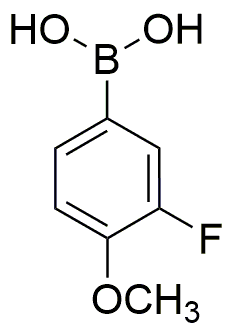3-Fluoro-4-methoxyphenylboronic acid is widely utilized in research focused on:
- Pharmaceutical Development: This compound serves as a key intermediate in the synthesis of various pharmaceuticals, particularly in the development of drugs targeting cancer and diabetes.
- Organic Synthesis: It is employed in cross-coupling reactions, such as Suzuki-Miyaura coupling, allowing for the construction of complex organic molecules with precision and efficiency.
- Material Science: The compound is used in the creation of advanced materials, including polymers and nanomaterials, which have applications in electronics and coatings.
- Bioconjugation: Its boronic acid functionality allows for selective binding to diols, making it useful in bioconjugation processes for labeling biomolecules in research and diagnostics.
- Analytical Chemistry: It is utilized in sensor technology for detecting glucose and other biomolecules, providing a reliable method for monitoring health conditions.
Información general
Propiedades
Seguridad y normativas
Aplicaciones
3-Fluoro-4-methoxyphenylboronic acid is widely utilized in research focused on:
- Pharmaceutical Development: This compound serves as a key intermediate in the synthesis of various pharmaceuticals, particularly in the development of drugs targeting cancer and diabetes.
- Organic Synthesis: It is employed in cross-coupling reactions, such as Suzuki-Miyaura coupling, allowing for the construction of complex organic molecules with precision and efficiency.
- Material Science: The compound is used in the creation of advanced materials, including polymers and nanomaterials, which have applications in electronics and coatings.
- Bioconjugation: Its boronic acid functionality allows for selective binding to diols, making it useful in bioconjugation processes for labeling biomolecules in research and diagnostics.
- Analytical Chemistry: It is utilized in sensor technology for detecting glucose and other biomolecules, providing a reliable method for monitoring health conditions.
Documentos
Hojas de datos de seguridad (HDS)
La SDS proporciona información de seguridad completa sobre la manipulación, el almacenamiento y la eliminación del producto.
Especificación del producto (PS)
La PS proporciona un desglose completo de las propiedades del producto, incluida la composición química, el estado físico, la pureza y los requisitos de almacenamiento. También detalla los rangos de calidad aceptables y las aplicaciones previstas del producto.
Certificados de análisis (COA)
Busque certificados de análisis (COA) ingresando el número de lote del producto. Los números de lote y de partida se pueden encontrar en la etiqueta de un producto después de las palabras "Lote" o "Lote".
Número de catálogo
Número de lote/lote
Certificados de origen (COO)
Este certificado de origen confirma el país en el que se fabricó el producto y también detalla los materiales y componentes utilizados en él y si se deriva de fuentes naturales, sintéticas u otras fuentes específicas. Este certificado puede ser necesario para cumplir con las normativas aduaneras, comerciales y regulatorias.
Número de catálogo
Número de lote/lote
Hojas de datos de seguridad (HDS)
La SDS proporciona información de seguridad completa sobre la manipulación, el almacenamiento y la eliminación del producto.
DownloadEspecificación del producto (PS)
La PS proporciona un desglose completo de las propiedades del producto, incluida la composición química, el estado físico, la pureza y los requisitos de almacenamiento. También detalla los rangos de calidad aceptables y las aplicaciones previstas del producto.
DownloadCertificados de análisis (COA)
Busque certificados de análisis (COA) ingresando el número de lote del producto. Los números de lote y de partida se pueden encontrar en la etiqueta de un producto después de las palabras "Lote" o "Lote".
Número de catálogo
Número de lote/lote
Certificados de origen (COO)
Este certificado de origen confirma el país en el que se fabricó el producto y también detalla los materiales y componentes utilizados en él y si se deriva de fuentes naturales, sintéticas u otras fuentes específicas. Este certificado puede ser necesario para cumplir con las normativas aduaneras, comerciales y regulatorias.


